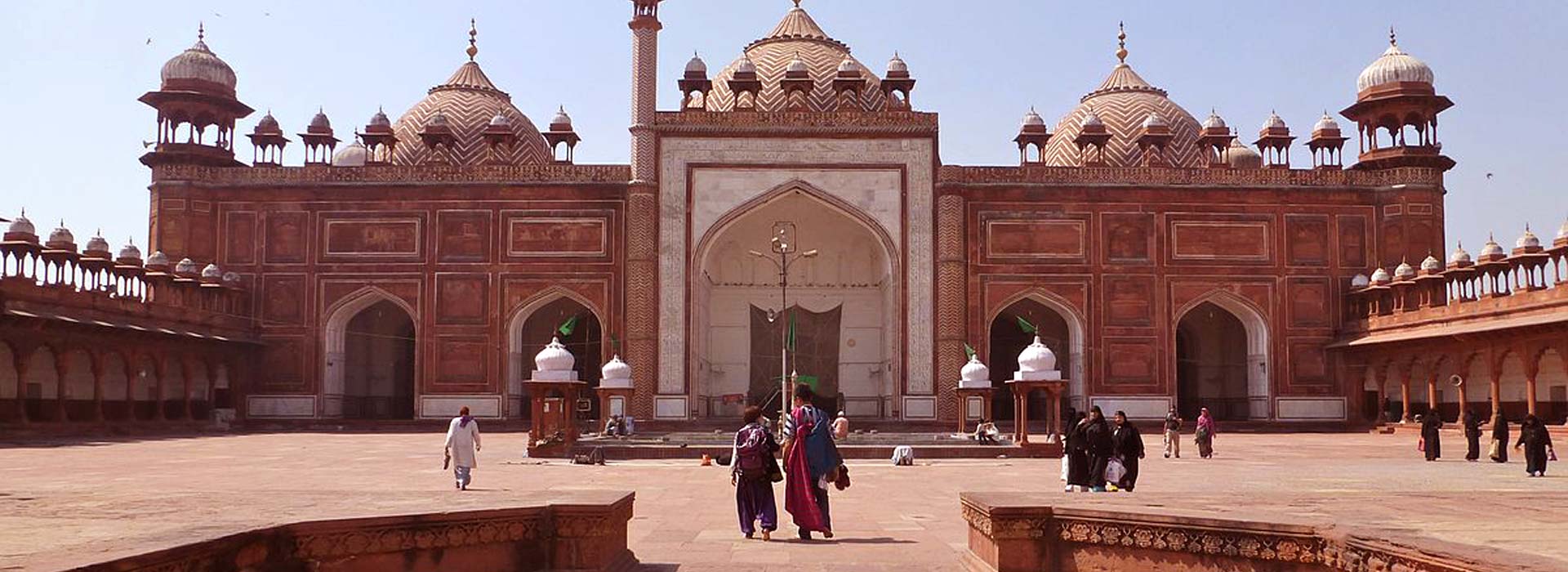Jama Masjid
History
The Mosque was built by Mughal emperor Shahjahan in 1648 and dedicated to his favourite daughter, Jahanara Begum. There was a spacious, octagonal Tripolia Chowk which existed between the Jama Masjid and the Delhi gate of the Agra Fort. This Tropolia was destroyed in order to create the Agra Fort Railway Station. The cloisters have engraved arches supported on pillars. The main entrance is through the eastern side. The prayer chamber has a facade with a broad arched iwan in its centre and is adorned with slender turrets alternated with kiosks. Its dome is the largest and highest of the three domes crowning the sanctuary.
All the bulbous domes have inverted lotus and kalash finials on the top and have narrow zigzag courses of white marble alternated by broad bands of red stone. There is a fountain with four kiosks in its corners in the centre of the courtyard. The interiors of the western wall have a beautiful mihrab and pulpit in white marble. The Persian inscription in white marble inlaid with black stone on the archway of the central portal is in praise of Jahanara and Shah Jehan. The pristine beauty of the mosque must have been awesome as indicated by its comparison with Baitul-Mamur, the fabulous mosque of rubies and pearls situated in the fourth sky. It is said that it was once surrounded by a marketplace called Tripolia set in an octagonal (Muthamman) Chowk that was built between the Delhi Gate and the Jami Masjid. But, it was later destroyed in 1871-1873 to acquire space for laying down the railway tracks for the city. It required six years and 5000 workers to finish. It was made by using red sandstone and marble.
Architecture
The Jama Masjid of Agra is constructed of red sandstone with intricate white marble decorations. The walls and ceilings of the mosque are painted blue in color. It is a huge mosque in the center of Agra surrounded by a great bazaar.
The Mosque itself stands on a high platform to which ascent is made by a flight of 35 steps. It was designed to attract the eye of the faithful from afar and proclaim the glory of Islam.
Jama Masjid is the second most visited place in Agra after the Taj Mahal. A few steps high, it has various domes, out of which the prayer dome is the largest. Buland Darwaza is forty meters high and is built of red sandstone. It is semi octagonal in pattern and contains three massive domes at the top. These domes are followed by three smaller domes and twelve tiny domes at lower levels.
The impressive arches at the courtyard are supported by pillars covered in red sandstone. The domes are decorated by an inverted lotus and are ornamented by a Kalash at the top. The designs on top of these domes are made of alternating stripes of marble and red sandstone. There is a Madrasa in the central courtyard, where small kids are taught Islamic language and culture. The interior walls have been made up of white marble singing the praise of the ruler in Persian inscriptions. Entry to the mosque is possible through five entrances. The gateway is embellished with small layers of sandstone. The Iwan( a rectangular hall walled on three sides) has a central arch with several geometric patterns.
Friday Prayer at Jama Masjid
Special Namaz is conducted at Jama Masjid every Friday, which is attended by devotees in large numbers. This is the only day when this place sees huge crowds which remain quite empty and serene on the other days. Jama Masjid is considered to be very sacred by the Muslims; hence tourists are expected to observe silence when they go to the mosque.
How to Reach
Jama Masjid is located right opposite to the Agra Fort Railway Station, thus easy to reach. For more information & to get experience about its history, the better way is to get in touch with a Tour Guide. Therefore if you wish to go alone, you can hire an auto rickshaw from any part of the city to reach the mosque.


